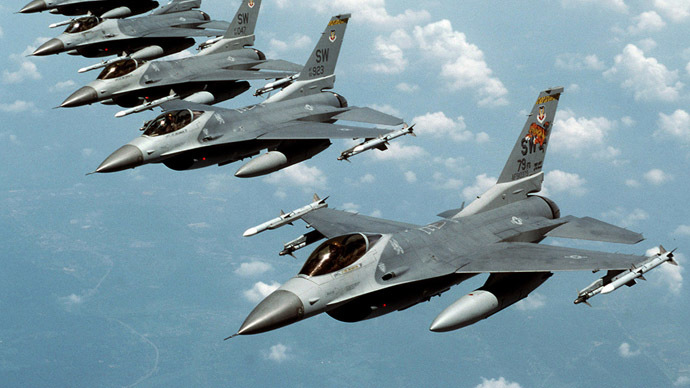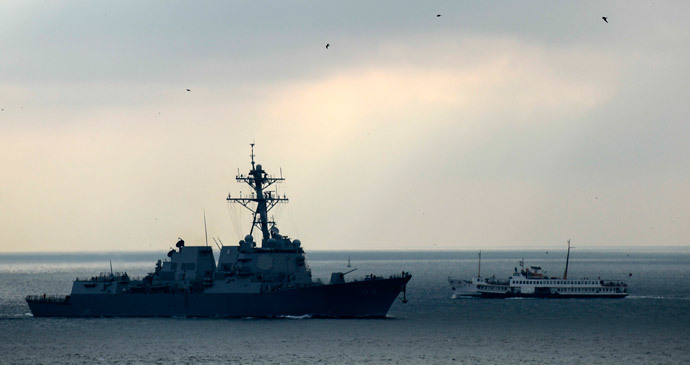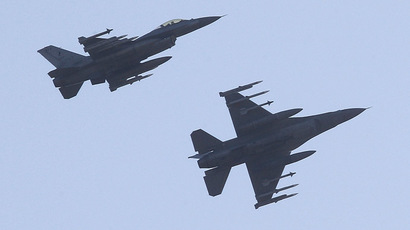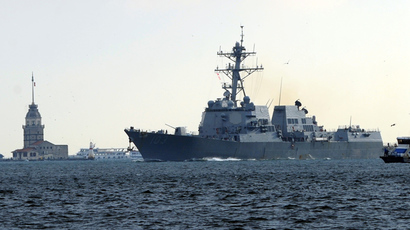NATO starts air drills close to Ukraine's borders

NATO has begun wargames in Poland as recently dispatched US jets are set to take part in the exercises. Poor weather has delayed naval maneuvers in the Black Sea, with the US saying both drills were planned before the outbreak of unrest in Ukraine.
The air drills began on Tuesday at the Lask Air Base in central Poland. Polish President Bronislaw Komorowski was present as the exercises commenced, standing by as four Polish F-16s lifted off. A US Hercules transport plane landed with support staff, while at least 12 US F-16 fighter jets and 300 personnel are due to arrive by Thursday.
Komorowski, without directly naming Crimea, said "events to the east" provided a reason to protect military spending in an age of austerity.
"I hope events to the east of the Polish border, which is also NATO's border, will encourage tough decisions regarding Polish security," Reuters cites him as saying.
The decision to deploy the US jets followed a phone conversation between US Defense Secretary Chuck Hagel and his Polish counterpart Tomasz Siemoniak on Sunday. Washington insisted the air exercise was planned long in advance, though Siemoniak maintains the exercise was to have been smaller, only involving transport aircraft.
Following recent events in Crimea, however, Siemoniak asked the Pentagon to send fighter jets instead.
"This was our request," Reuters cites Siemoniak as saying at a Polish Rocket Defense site. "We really appreciate that the reaction was that quick and significant."
On Monday, NATO also gave the green light to Airborne Warning and Control System (AWACS) for reconnaissance flights over Poland and Romania in order help monitor the crisis in Ukraine. The planes are slated to fly from their home airbases in Geilenkirchen, Germany and Waddington in Britain, from where they will cross Romanian airspace on Tuesday.
That follows a decision made by the US last week to send a KC-135 aerial refueling plane and six F-15 fighter jets to Lithuania to bolster NATO’ air patrol over Baltic airspace. Those ships will reinforce four F-15s, which arrived on January 1 to fill NATO’s Baltic Air Policing rotation. The rotations is scheduled to end April 30.
Baltic allies had requested the assistance amid a growing standoff between Ukraine and Russia on the Crimean Peninsula. Following the deployment, US Secretary of State John Kerry said that the modest US military deployment should be viewed as “concrete steps to reassure our NATO allies.”
Meanwhile, strong winds and high seas have caused the US and its NATO allies Bulgaria and Romania to delay the naval portion of its military exercises by 24 hours, the Bulgarian defense ministry said.
“The weather is now improving, the sea is not that rough and I don't expect another postponement," Reuters cites Lieutenant-Colonel Dimitar Titev as saying.
Washington said both the air drills and the joint Black Sea exercises with Romania and Bulgaria, which were delayed due to bad weather, were scheduled long before crisis struck Ukraine.

On Saturday, US Navy destroyer, the USS Truxtun, crossed Turkey's Bosphorus strait and entered the Black Sea. The ship, with around 300 crew, was heading to “previously planned” training exercises with the Bulgarian and Romanian navies. The exercise is not expected to entail any live-fire component.
The USS Truxton, one of the largest destroyers ever built for the US Navy, had been expected to visit the Bulgarian port of Varna March 12-14. However, Titev said he was presently unable to predict what its estimated time of arrival would now be as a result of the inclement weather.
The Bulgarian naval frigate Drazki, and three Romanian naval vessels will take part in the drill, which will be held in international waters southeast of the Romanian port of Constanta. Constanta lies about 220 miles from the Crimean port of Sevastopol, where Russia's Black Sea fleet leases a base.
The exercises come as the parliament of the Autonomous Republic of Crimea adopted an independence declaration from Ukraine which precedes a referendum slated for March 16.
The United States says it will not recognize the referendum on Crimea, while Russia’s State Duma has said it will only debate the issue of Crimea joining Russia only after the referendum takes place.
The crisis first erupted on February 28 when forces with no national insignia occupied airports and other strategic locations in Crimea. The West says the troops are under Russian control, a claim Russian President Vladimir Putin has denied. Local authorities have said the troops belong to local 'self-defense squads'. Under a current agreement with the Ukrainian government, Russia is allowed to have 25,000 troops stationed on the Crimean Peninsula.
Washington has accused Moscow of committing outright military aggression in Ukraine, while Russia denies invading the region, saying any action would take place within a framework of international law to protect Russian citizens from attack.
Putin said that Russia’s military involvement in Ukraine would take place only as a “last resort.”
Hopes of a diplomatic solution to the crisis were severely dampened after Kerry decided to cancel a visit to Moscow on Monday to discuss the issue with his Russian counterpart Sergey Lavrov.














